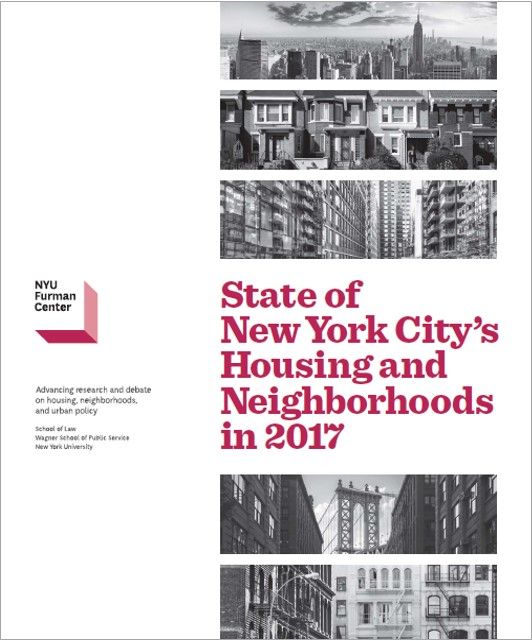
State of New York City’s Housing and Neighborhoods in 2017

The State of New York City’s Housing and Neighborhoods report, published annually by the NYU Furman Center, provides a compendium of data and analysis about New York City’s housing, land use, demographics, and quality of life for each borough and the city’s 59 community districts. Indicators are available for download on CoreData.nyc.
Each year, the State of New York City’s Housing and Neighborhoods report describes, contextualizes, and provides analysis on a pressing and policy-relevant issue affecting New York City. This year, the report focuses on changes in New York City’s housing stock. It describes the housing in the city today and how it has changed over time. It also examines factors that drive demand for housing, and indicators that measure whether supply is adequately moderating pressures on rents and housing prices that result from increases in demand.
READ THE REPORT: State of New York City’s Housing and Neighborhoods in 2017 (PDF) or Focus on Changes in New York City’s Housing Stock (PDF)
ACCESS THE DATA: All information in the State of New York City’s Housing and Neighborhoods in 2017, plus expanded and historical data, is available for download on CoreData.nyc.
Citywide Analysis: Key Findings
State of New Yorkers
The share of households with children declined from 34 percent to 29 percent between 2000 and 2016, with the largest declines in Brooklyn and the Bronx. The decline in the share of households with children citywide (-4.9 percentage points) mirrored a nationwide trend.
While the share of New Yorkers who were born outside of the United States increased between 2000 and 2016, Brooklyn was the only borough to experience a decrease in its foreign-born share.
Citywide, real median household income increased by more than four percent between 2015 and 2016, reaching $60,000—the highest level in a decade.
State of Land Use and the Built Environment
The number of permits issued for new housing units in New York City increased by 35.6 percent between 2016 and 2017. The majority of the newly authorized housing units (62.4%) were in buildings with 50 or more units.
The city designated 18 individual and interior landmarks in Brooklyn, Manhattan, and Queens in 2017.
State of Homeowners and their Homes
Citywide, home prices rose by 8.3 between 2016 and 2017. Staten Island and the Bronx experienced the largest year-over-year increases, while Manhattan homes prices increased only slightly (+0.8%).
Sales of smaller buildings, condominums, and co-ops increased between 2016 and 2017, while sales of five plus unit rental buildings experienced a slight decline.
State of Renters and their Homes
For the second time since 2012, real median renter household income rose faster than real median rent in 2016. Still, over the past decade, median rents increased more than median renter income.
The citywide median asking rent in 2017 was $2,695. Median asking rent in some Manhattan neighborhoods was double the median asking rent in most Bronx neighborhoods. Fewer recently available rental units citywide were affordable to low- and moderate-income households in 2016 than in 2006.
State of Neighborhood Services and Conditions
For the fourth year in a row, student performance in math rose citywide, with the largest gains in Manhattan. Nevertheless, the disparity between the Bronx and other boroughs persisted.
High school graduation rates improved citywide in 2017. Over 70 percent of the Class of 2017 graduated high school within four years, which was the highest graduation rate in at least the past decade.
Over 70 percent of New Yorkers commuting to work took some form of public transit. While subway ridership has remained steady, bus ridership is down nearly 25 percent since 2007.
READ THE REPORT: State of New York City’s Housing and Neighborhoods in 2017 (PDF) or Focus on Changes in New York City’s Housing Stock (PDF)
ACCESS THE DATA: All information in the State of New York City’s Housing and Neighborhoods in 2017, plus expanded and historical data, is available for download on CoreData.nyc.


